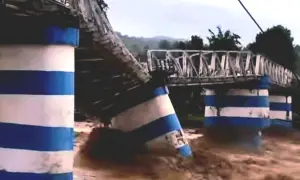Communities across eastern Australia are facing a massive recovery effort after record-breaking floods submerged towns, claimed at least four lives, and left tens of thousands of residents isolated.
The disaster struck when storms dumped more than six months' worth of rain on parts of New South Wales in just three days, turning rivers into raging torrents and breaking rainfall records that had stood for nearly a century.
As floodwaters begin to recede, residents are returning to find their homes and businesses in ruins. In the town of Taree, the Manning River surged past a 96-year record, causing widespread destruction.
"Emotions were high," said rescue worker Jason Harvey. "We are now at that clean-up stage. I am glad it is over, but it's going to be a long road ahead."
Emergency services have rescued more than 600 people, many of whom were stranded on rooftops, cars, and highway bridges. At the height of the crisis, approximately 50,000 people were cut off from essential services.
Government Response and Recovery Efforts
Australian Prime Minister Anthony Albanese visited the affected areas on Friday, describing the scenes as "horrific."
"There's been massive damage to infrastructure, and we're going to have to all really pitch in," the Prime Minister said during a local radio interview.
The federal government has declared the floods a natural disaster, unlocking emergency funding for affected communities. The Australian Defence Force has been deployed to support recovery operations.
State Emergency Service chief Dallas Burnes warned that dangers remain even as waters recede. "Floodwaters are contaminated and dangerous," Burnes said. "There are vermin, snakes, and possible electrical hazards. We urge people to be extremely cautious."
Human and Environmental Impact
In Kempsey, dozens of homes were inundated. Mayor Kinne Ring described the situation as heartbreaking: "Houses have been inundated, it's really awful to see, and the water is going to take time to go down."
The disaster has also affected wildlife, with conservation group Aussie Ark reporting that endangered Tasmanian Devils had to be relocated from their sanctuary. Dead livestock have been spotted washing ashore along the coast, indicating the severe impact on farming communities inland.
For business owners like Jeremy Thornton from Taree, the emotional toll is immense. "It's gut-wrenching," Thornton said. "We are reliving it every second — hearing the rain, the helicopters, the sirens. But we'll push on."
Climate Change Concerns
Experts are pointing to climate change as a factor amplifying the severity of the disaster. According to the Australian Bureau of Meteorology, ocean temperatures around the continent have been "abnormally warm," increasing the likelihood of extreme rainfall events.
"Warmer seas mean more evaporation and, eventually, heavier downpours. What we're seeing this week is compelling evidence of how climate change is amplifying natural disasters," explained flood modeller Mahdi Sedighkia.
While more rain is expected in parts of the region in the coming days, officials hope it will not trigger further flooding as communities begin the difficult process of rebuilding their lives.













